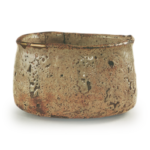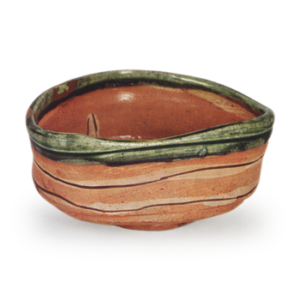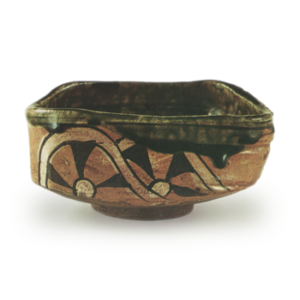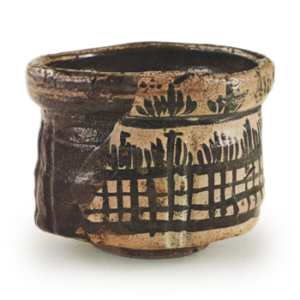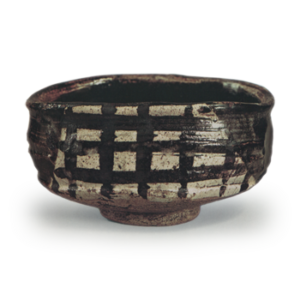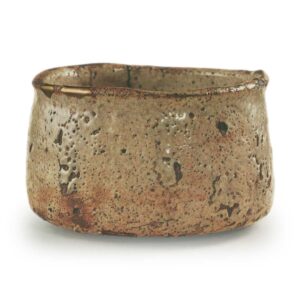
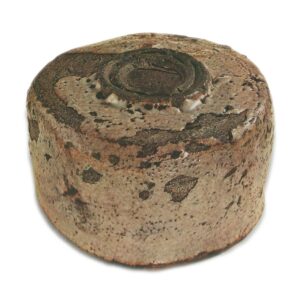
Height: 8.7cm
Base diameter: 13.7-14.0cm
Outer diameter of foot ring: 6.3-6.5cm
Height of foot ring: 0.5cm
The name “Sengoku” may indicate the size of the tea bowl, which is as large as a thousand-koku boat, or it may express the dignity of a thousand koku. In any case, this is a Shino tea bowl of unparalleled magnificence and boldness.
Firstly, the clay is relatively coarse and seems to contain a little iron. The clay on the underside of the base is a light brown color and appears to have been fired hard. The powerful sword-like brushstrokes on the double foot ring are in harmony with this earthy quality.
The shape is low-slung, the base is flat and wide, and the foot ring is low, and this area is similar to the style of Setoguro. In addition, the rim is slightly convex overall, and it undulates gently, and the inside is deep and wide, with large whorls of the lathe marks. Both inside and out, the strong tone of the large, raised areas made on the potter’s wheel is left intact, and there is almost no evidence of deformation by the use of a spatula or the fingertips here. Overall, the appearance is large and full of spirit, despite the hazy atmosphere.
The glaze is applied generously to the entire surface, with the exception of the foot ring and a small area next to it, and there are many rough patches here and there. The color is a slightly grayish white, but as usual, the thin layers of glaze are unevenly colored by the fire, creating a beautiful light pink color. Also, perhaps due to the material or the firing, there are many small holes in the glaze, especially on the exterior. Furthermore, the crazing of the glaze and the large and small flakes of glaze are rough, and it is also noticeable that it looks like a peeling of the skin or insect damage. In particular, from the foot of the rim to the waist, there are large and small flakes of glaze, and it seems that something rough is gushing out from here.
The painting is light on the outside, and the bridge railing forms a large arc. The brushwork is simple and plain, and it is extremely interesting, but it is extremely light, so at first glance it looks like plain Shino ware.
In addition, the character “ni” is clearly and sharply carved into the foot ring. This is a seal that is not found in either the Seto Rokusaku or the Jussaku, and its origin is unknown. According to Arakawa Toyozo, this tea bowl is said to have been made at the Muta-dō kiln in Mino Ōgaya.
As an accessory, a slip of paper with a price tag is included in a box with the inscription “Sumiyoshi Shino-yaki teacup Sen-goku”. According to this,
Ansei 3rd year, purchased from Motohisa, Tayama-ko-te, this item was previously owned by the head family, and when purchased by the head family, it cost 12 ryou
and on the wrapping paper
Koushoku Kuwabara Hokata Watanabe Saemon-sama Kyomachida Souha Chin Sousai
can be seen. The author, Souha Machida, died in 1860 and was a tea master of the Omotesenke school. The other origins of the tea utensils are not known.

